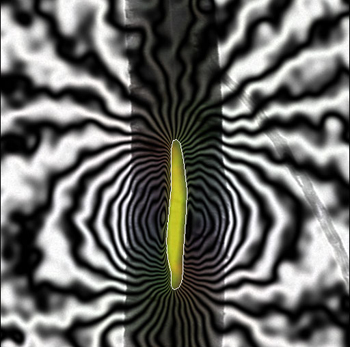Friday, January 26, 2007
Picture of the day
This image won First Prize in the "Science Close-Up" category in the Daily Telegraph Visions of Science competition. The image shows a multi-walled carbon nanotube, approximately 190nm in diameter, containing a 35-nm-diameter iron crystal encapsulated inside it. Electron holography has been used to obtain a map of the magnetic field surrounding the iron particle, at a spatial resolution of approximately 5nm. The magnetic phase contours show that the particle contains a single magnetic domain. An external magnetic field could be applied to such particles to exert a torque on the surrounding nanotube. (click to see full sized version)
Acknowledgments: Takeshi Kasama, Rafal Dunin-Borkowski, Krzysztof Koziol, Alan Windle
Visit the University of Cambridge Department of Materials Science & Metallurgy Gallery.
I will post the others in this series over time. To see it all now, visit the Nanotechnology Now Gallery.
Quote of the day
"The future is not a roulette wheel that we sit back and watch as worried spectators. It's a matter of work. We should see the risks, see the possibilities, and do what we can to make sure that future outcomes are the ones that we desire."
~Jeffrey Sachs, director of the Earth Institute at Columbia University
Interview with Adriana Vela
Today, I would like to call your attention to an interview I did with Adriana Vela, Founder & Chair, NanoBioNexus. In addition to creating and running the community building non-profit, Adriana is both a friend and colleague. She is well versed in the nuances pertaining to community outreach and education for applications of nanotechnology and oncology, as well as for partnering and investment opportunities in nanobiotechnology.
RR: How are advances in nanotechnology enabling biotechnology?
Nanotechnology is an interdisciplinary science that combines chemistry, physics, biology and mechanical engineering. Nanotechnology is generating substantial new insights into how biological systems work and this will lead to the design and creation of entirely new classes of nanofabricated devices and systems. Nanotechnology facilitates new methods for scientific exploration thus increasing the understanding of how biological systems work and accelerating our ability to address diseases at the cellular level.
RR: What is the most important point that nanobiotech companies and research institutions need to consider prior to forming a partnership?
As an enabling technology, nanotechnology has millions of potential applications, most of which have not even been thought of yet. This can be a double-edge sword in that the original (potential) applications of the technology may be set aside when product-development partners use the technology in ways that differ from the original vision. So the point is: don't get discouraged if your technology doesn't end up being used as you envisioned.
RR: On your web site you ask the question "Why is it important to pay attention to nanotechnology?"
In response, what do you tell prospective partners? Ultimately, the answer to this question is different for every individual. In general, I make the point that nanotechnology is a transformative technology not so different from the locomotive in the 18th century, electricity in the 20th century, and the internet in recent times. From a materials standpoint, nanotechnology introduces novel properties and functions, so it is not that different from when plastic first arrived on the scene. Back in 1907, Nobody could foresee the plethora of uses of plastics. With such capacity and potential, it is important to pay attention to nanotechnology and understand how that might affect you from the health, environment, and business or investment opportunity perspectives.
There are many ways that NanoBioNexus can help you with your nanobiotech goals and questions. As stated on their home page "NanoBioNexus aims to demystify the constantly evolving developments in nanobiotechnology and highlight the implications to society."
I encourage you to visit the their website to learn more.
http://nanobionexus.org
To read the entire interview, visit:
http://www.nanotech-now.com/products/nanonewsnow/issues/026/026.htm#Vela










